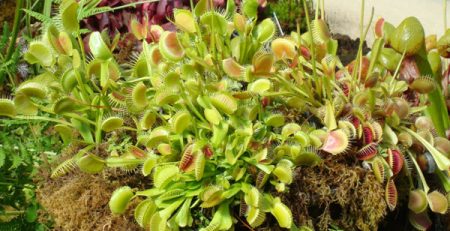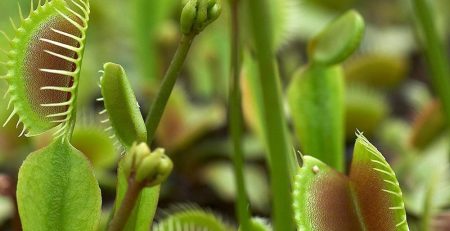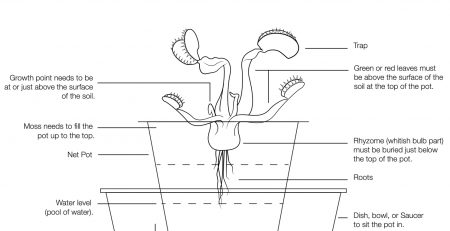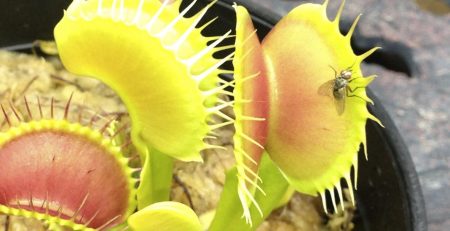Official CarnivorousPlants.com Venus Flytrap Care Sheet, Part 2
Light: Venus Flytraps need strong light. They can be grown indoors next to a very sunny window where sunlight can
visibly shine on the plant for 4 hours or more each day. The bottom center of a window is usually the brightest spot. THERE SHOULD BE NO SCREENING, closed or open blinds, tinting, a large tree, or an overhang on or in front
of the window your VFT is receiving light through. The bottom center of a window is usually the best spot for your VFT. It’s possible your VFT can die from light deprivation in as little as a week if any of these things are weakening light to your VFT. They should not be moved back and forth from inside to outside daily. Sunlight through clouds is still good usable light. If you cannot provide a sunny window that receives 4 hours or more of direct sunlight or grow your VFT outside then you can use a red and blue plant LED grow light or a fluorescent light by itself or next to a less well lit window. If you are using an artificial light to grow your VFT make sure to follow the artificial lighting directions on the back of the potting diagram. They can also be grown outside in a sunny spot, provided it is not both extremely hot and dry.
Water: Do not water VFTs with tap water, purified water, drinking water, Spring water, well water, or mineral
water because these kinds of water will kill your VFT. They must have Distilled water or reverse osmosis water
only. Distilled and reverse osmosis water are specific types of bottled water. Not all bottled water is distilled or reverse osmosis water. You can buy Distilled or Reverse Osmosis water at a water store or grocery store by the gallon. Just check the fine print to make sure it doesn’t have anything else added to it, for example minerals or electrolytes.
When the water evaporates to near the bottom of the container your VFT’s pot is sitting in refill it back to about 1/4th the way up the pot again. Never let the Venus Flytrap’s pool of water completely dry out. If you plan on growing your VFT outside keep in mind that the water level will go down faster outside and you may need to check it daily. If you plan on doing this I recommend upgrading to a 5 or 6 inch pot 2 months or so after your plant has been in its first pot. You can buy 5 or 6 inch pots and/or additional moss through the link at the top of this web site.
Feeding: It is best to wait 3 days after your Venus Flytrap is transplanted to feed it. Do not feed your VFT
mealworms. They can damage your VFT. VFTs can eat 1 live insect a week per whole plant, regardless of how many
traps are on the plant, that is no more than 1/3rd the size of the trap being fed. If your plant is very warm most of the time it can eat twice this amount. If you do not feed your VFT at all it will not die. It will just grow more slowly. VFTs should not be fed if they are dormant. If you grow your VFT outside you do not need to feed it all. It will catch bugs on its own. Don’t use fertilizers for your VFT. Leaf/Trap Growth: Each season Venus Flytraps make different shaped leaves that only last about 3 months and are then replaced. 2/3rds to 3/4ths of the year their leaves lie on the ground. If your Venus Flytrap has a leaf and trap or two blackening don’t worry this is 100% normal, as long as there is also fresh new healthy leaves with traps emerging. VFTs shed a little more leaves and traps than usual in late Summer/early Fall. When they go dormant in late Fall/early Winter they shed almost all of their leaves and traps.
Dormancy: Every Winter VFTs need to go dormant but if you bought your VFT from me between November and February it may not need a Winter dormancy for its first Winter in your care. If you grow your VFT outdoors and you get more than a light frost where you live you will need to put it inside 1-2 inches next to the glass of a sunny windowsill for the winter. Do not put it back outside until the last frost is over. If you grow your VFT inside all the time just be sure to move it 1-2 inches next to the glass of a sunny window during the Wintertime to chill it a little so it will go dormant. If you only get light frosts where you live during the Winter and you grow your VFT outside you can leave your VFT outside for the Winter. When VFTs go dormant their Fall leaves dry up and turn black and they grow small leaves or no leaves for all of Winter. They will regrow right back every Spring and maybe make a flower for you too.












Leave a Reply
You must be logged in to post a comment.